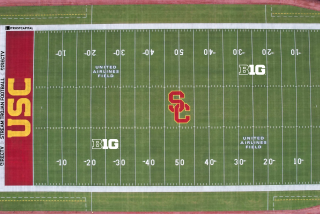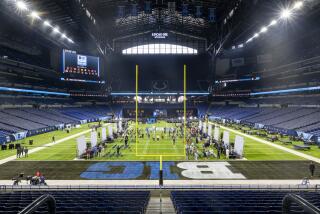Commentary : Athletes Not the Only Exploited Students on Campus These Days
Every once in a while the plight of the student-athlete makes the cover of a national magazine. He’s producing $68 million in television revenue for the NCAA basketball tournament and what does he get for it? Poor devil gets exploited, that’s what.
Then I think of other students on the campus and suddenly the athlete isn’t quite so exploited. Other students are really the ones being exploited. Maybe I’m being exploited.
The Division I athlete puts in a lot of time, no question. A recent study said that he spent an average of 28 hours a week practicing. What does he get for producing the $1.2 million for each team in the Final Four? In almost all cases he gets a full scholarship.
If you consider that at a number of schools, an athletic scholarship is good for five years, a full ride can be worth $100,000. Not to mention the value of an education in the marketplace. Maybe there’s a chance to be a multimillionaire superstar. Maybe they live in the privacy of athletic dormitories, known familiarly as beast barracks. And they may not even have to learn to speak English.
The school gets the money, it gets the visibility and it gets golden exposure.
The NCAA Tournament looks like big money, but it’s hardly a fraction of the amount the school gets from federal and foundation grants for research and study. The federal government gave $9 billion to universities in 1988.
Syracuse University got $394,000 for data processing on multi-nuclei magnetic resonance, $606,000 to study intensity effects on the auditory and tactile system, $3.7 million for a three-year project to computerize access to adult education materials, and more.
Think of the poor devils in white coats slaving over hot Bunsen burners in biology labs all across this land, or the students in green eyeshades developing those programs.
There’s a Biological Undergraduate Research Program at Syracuse, known familiarly as BURP. Freshmen are eligible in the second semester, which is when John Thompson first permits the press to speak with his players. They spend a minimum of eight hours a week in the early stages, a minimum of 20 and a maximum of 30 hours a week by juniors, according to Dr. Carroll Kuehnert, director of the program.
One researcher successfully reproduced lung tissue in the laboratory so it’s no longer necessary to sacrifice laboratory animals. Nobody had been able to do that before. That’s a great credit to Syracuse in the scientific community.
“They’re also carrying a full course load, many of them in honors programs,” Kuehnert said. “Some of them have work-study support, washing dishes or working in the library or in the parking office. I don’t think any of them get a full scholarship; the best of them get some money toward tuition. There are no special dormitories. They also find some time for rest and recreation, although I don’t know how.”
Think of the poor devils of student trainers who wrap and tape the athletes and apply the liniment and the ice. My Darling Daughter is required to work 950 hours in the training room, which is about 12 hours a week and more like 20 in the season that she’s responsible for traveling with a team. And she doesn’t get so much as a hamburger for her time.
What of the music major at Indiana University? He or she will practice four or five hours a day on skills, and if he or she is singing “Aida,” that could mean two more hours a day for three months. The orchestra demands 90 hours a semester, minimum. The Indiana University opera performed at Lincoln Center last summer; this summer it’s to open the 200th anniversary of Bastille Day in Paris. It will bring considerable prestige to the university. “They don’t get paid a cent -- just living expenses,” said Charles Webb, School of Music dean.
Only Thomas Jefferson thought of the student newspaper people. You remember, he said if he had to choose between basketball and no student newspapers, or student newspapers and no basketball, he would most assuredly choose the latter. Tom Yee will be editor in chief of the Indiana Daily Student next fall. He already puts in 50 or 60 hours a week on the paper as a senior editor.
Reporters covering the football and basketball teams spend all those practice hours around the teams and then have to write. They travel on their own. Usually they drive from Bloomington to Iowa City, which means missing Friday or Monday classes. And Bob Knight hasn’t talked to the Indiana Daily Student for 11 years.
Yee figures he takes a full load of classes, gets to The Student about 3 in the afternoon and works five nights until 11 o’clock and sometimes until 3 a.m. “We eat wings a lot for dinner,” he said. “If you want to eat, you pay for it.” Upper level editors are paid $120 every two weeks and reporters $4 a story of more than 300 words. There are few million-dollar newspaper jobs waiting when eligibility has been used up. Half the staff works part-time on traditional campus jobs such as picking up cafeteria trays. “If your grades suffer, you knew that going in,” Yee said. “You don’t get much sleep either.”
But it’s better than it used to be. We worked the same hours and pay was only theoretical.
“I don’t know you should feel sorry for the students involved,” said Kuehnert, the research director at Syracuse. “While they’re not getting money out of it, they are getting an educational experience that could not be purchased. Their educational horizons are being broadened at such a rate that when the opportunity arises, they’re prepared.”
Oh, could it be that’s why they went there in the first place?
More to Read
Go beyond the scoreboard
Get the latest on L.A.'s teams in the daily Sports Report newsletter.
You may occasionally receive promotional content from the Los Angeles Times.










